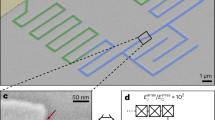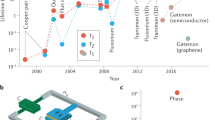Abstract
Superconducting quantum information processing machines are predominantly based on microwave circuits with relatively low characteristic impedance, about 100 Ω, and small anharmonicity, which can limit their coherence and logic gate fidelity1,2. A promising alternative is circuits based on so-called superinductors3,4,5,6, with characteristic impedances exceeding the resistance quantum RQ = 6.4 kΩ. However, previous implementations of superinductors, consisting of mesoscopic Josephson junction arrays7,8, can introduce unintended nonlinearity or parasitic resonant modes in the qubit vicinity, degrading its coherence. Here, we present a fluxonium qubit design based on a granular aluminium superinductor strip9,10,11. We show that granular aluminium can form an effective junction array with high kinetic inductance and be in situ integrated with standard aluminium circuit processing. The measured qubit coherence time \(T_2^ \ast \le 30\,{\upmu}{\mathrm{s}}\) illustrates the potential of granular aluminium for applications ranging from protected qubit designs to quantum-limited amplifiers and detectors.
This is a preview of subscription content, access via your institution
Access options
Access Nature and 54 other Nature Portfolio journals
Get Nature+, our best-value online-access subscription
$29.99 / 30 days
cancel any time
Subscribe to this journal
Receive 12 print issues and online access
$259.00 per year
only $21.58 per issue
Buy this article
- Purchase on Springer Link
- Instant access to full article PDF
Prices may be subject to local taxes which are calculated during checkout



Similar content being viewed by others
Data availability
All relevant data are available from the corresponding author.
References
Gu, X., Kockum, A. F., Miranowicz, A., Liu, Y.-X. & Nori, F. Microwave photonics with superconducting quantum circuits. Phys. Rep. 718, 1–102 (2017).
Willsch, D., Nocon, M., Jin, F., De Raedt, H. & Michielsen, K. Gate-error analysis in simulations of quantum computers with transmon qubits. Phys. Rev. A 96, 62302 (2017).
Manucharyan, V. E., Koch, J., Glazman, L. I. & Devoret, M. H. Fluxonium: single Cooper-pair circuit free of charge offsets. Science 326, 113–116 (2009).
Pop, I. M. et al. Coherent suppression of electromagnetic dissipation due to superconducting quasiparticles. Nature 508, 369–372 (2014).
Earnest, N. et al. Realization of a Λ system with metastable states of a capacitively shunted fluxonium. Phys. Rev. Lett. 120, 150504 (2018).
Lin, Y.-H. et al. Demonstration of protection of a superconducting qubit from energy decay. Phys. Rev. Lett. 120, 150503 (2018).
Masluk, N. A., Pop, I. M., Kamal, A., Minev, Z. K. & Devoret, M. H. Microwave characterization of Josephson junction arrays: implementing a low loss superinductance. Phys. Rev. Lett. 109, 137002 (2012).
Bell, M. T., Sadovskyy, I. A., Ioffe, L. B., Kitaev, A. Y. & Gershenson, M. E. Quantum superinductor with tunable nonlinearity. Phys. Rev. Lett. 109, 137003 (2012).
Pracht, U. S. et al. Enhanced Cooper pairing versus suppressed phase coherence shaping the superconducting dome in coupled aluminum nanograins. Phys. Rev. B 93, 100503(R) (2016).
Grünhaupt, L. et al. Loss mechanisms and quasiparticle dynamics in superconducting microwave resonators made of thin-film granular aluminum. Phys. Rev. Lett. 121, 117001 (2018).
Maleeva, N. et al. Circuit quantum electrodynamics of granular aluminum resonators. Nat. Commun. 9, 3889 (2018).
Roushan, P. et al. Chiral ground-state currents of interacting photons in a synthetic magnetic field. Nat. Phys. 13, 146 (2016).
Kandala, A. et al. Hardware-efficient variational quantum eigensolver for small molecules and quantum magnets. Nature 549, 242 (2017).
Langford, N. K. et al. Experimentally simulating the dynamics of quantum light and matter at deep-strong coupling. Nat. Commun. 8, 1715 (2017).
Sete, E. A., Reagor, M. J., Didier, N. & Rigetti, C. T. Charge- and flux-insensitive tunable superconducting qubit. Phys. Rev. Appl. 8, 24004 (2017).
Groszkowski, P. et al. Coherence properties of the 0-π qubit. New J. Phys. 20, 043053 (2018).
Yan, F. et al. The flux qubit revisited to enhance coherence and reproducibility. Nat. Commun. 7, 12964 (2016).
Samkharadze, N. et al. Strong spin-photon coupling in silicon. Science 359, 1123–1127 (2018).
Landig, A. J. et al. Coherent spin–photon coupling using a resonant exchange qubit. Nature 560, 179–184 (2018).
Viennot, J. J., Dartiailh, M. C., Cottet, A. & Kontos, T. Coherent coupling of a single spin to microwave cavity photons. Science 349, 408–411 (2015).
Corlevi, S., Guichard, W., Hekking, F. W. J. & Haviland, D. B. Phase-charge duality of a Josephson junction in a fluctuating electromagnetic environment. Phys. Rev. Lett. 97, 96802 (2006).
Arndt, L., Roy, A. & Hassler, F. Dual Shapiro steps of a phase-slip junction in the presence of a parasitic capacitance. Phys. Rev. B 98, 14525 (2018).
Niepce, D., Burnett, J. & Bylander, J. High kinetic inductance NbN nanowire superinductors. Phys. Rev. Appl. 11, 044014 (2019).
Hazard, T. M. et al. Nanowire superinductance fluxonium qubit. Phys. Rev. Lett. 122, 010504 (2019).
Peltonen, J. T. et al. Hybrid rf SQUID qubit based on high kinetic inductance. Sci. Rep. 8, 10033 (2018).
Shearrow, A. et al. Atomic layer deposition of titanium nitride for quantum circuits. Appl. Phys. Lett. 113, 212601 (2018).
Sun, L. et al. Measurements of quasiparticle tunneling dynamics in a band-gap-engineered transmon qubit. Phys. Rev. Lett. 108, 230509 (2012).
Müller, C., Cole, J. H. & Lisenfeld, J. Towards understanding two-level-systems in amorphous solids - insights from quantum circuits. Preprint at http://arXiv.org/abs/1705.01108 (2017).
Kou, A. et al. Fluxonium-based artificial molecule with a tunable magnetic moment. Phys. Rev. X 7, 031037 (2017).
Patel, U., Pechenezhskiy, I. V., Plourde, B. L. T., Vavilov, M. G. & McDermott, R. Phonon-mediated quasiparticle poisoning of superconducting microwave resonators. Phys. Rev. B 96, 220501 (2017).
Niemeyer, J. Eine einfache Methode zur Herstellung kleiner Josephson-Elemente. PTB-Mitt. 84, 251 (1974).
Dolan, G. J. Offset masks for lift-off photoprocessing. Appl. Phys. Lett. 31, 337–339 (1977).
Lecocq, F. et al. Junction fabrication by shadow evaporation without a suspended bridge. Nanotechnology 22, 315302 (2011).
Deutscher, G., Fenichel, H., Gershenson, M., Grünbaum, E. & Ovadyahu, Z. Transition to zero dimensionality in granular aluminum superconducting films. J. Low Temp. Phys. 10, 231–243 (1973).
Rotzinger, H. et al. Aluminium-oxide wires for superconducting high kinetic inductance circuits. Supercond. Sci. Technol. 30, 25002 (2017).
Blais, A., Huang, R.-S., Wallraff, A., Girvin, S. M. & Schoelkopf, R. J. Cavity quantum electrodynamics for superconducting electrical circuits: an architecture quantum computation. Phys. Rev. A 69, 062320 (2004).
Wallraff, A. et al. Strong coupling of a single photon to a superconducting qubit using circuit quantum electrodynamics. Nature 431, 162 (2004).
Kou, A. et al. Simultaneous monitoring of fluxonium qubits in a waveguide. Phys. Rev. Appl. 9, 64022 (2017).
Kumar, P. et al. Origin and reduction of 1/f magnetic flux noise in superconducting devices. Phys. Rev. Appl. 6, 41001 (2016).
le Sueur, H. et al. Microscopic charged fluctuators as a limit to the coherence of disordered superconductor devices. Preprint at http://arxiv.org/abs/1810.12801 (2018).
Catelani, G., Nigg, S. E., Girvin, S. M., Schoelkopf, R. J. & Glazman, L. I. Decoherence of superconducting qubits caused by quasiparticle tunneling. Phys. Rev. B 86, 184514 (2012).
Smith, W. C. et al. Fluxonium-resonator system in the nonperturbative regime. Phys. Rev. B 94, 144507 (2016).
Acknowledgements
We are grateful to A. Bilmes, J. Lisenfeld, C. Smith and M. Wildermuth for insightful discussions, and to J. Ferrero, A. Lukashenko and L. Radtke for technical assistance. Funding was provided by the Alexander von Humboldt Foundation in the framework of a Sofja Kovalevskaja award endowed by the German Federal Ministry of Education and Research, and by the Initiative and Networking Fund of the Helmholtz Association, within the Helmholtz Future Project ‘Scalable solid state quantum computing’. This work has been partially supported by the European Research Council advanced grant MoQuOS (no. 741276). I.T. and A.V.U. acknowledge partial support from the Ministry of Education and Science of the Russian Federation in the framework of the Increase Competitiveness Program of the National University of Science and Technology MISIS (contract no. K2-2017-081). Facilities use was supported by the KIT Nanostructure Service Laboratory. We acknowledge qKit for providing a convenient measurement software framework.
Author information
Authors and Affiliations
Contributions
L.G. and M.S. designed and fabricated the samples, and performed the measurements. D.G., S.T.S., I.T., F.V., P.W. and H.R. contributed to the sample fabrication effort. L.G. and M.S. analysed the data with help from N.M., W.W. and A.V.U. L.G., M.S. and I.M.P. led the paper writing, while all other authors contributed to the text. I.M.P. supervised and coordinated the project.
Corresponding author
Ethics declarations
Competing interests
The authors declare no competing interests.
Additional information
Publisher’s note: Springer Nature remains neutral with regard to jurisdictional claims in published maps and institutional affiliations.
Supplementary information
Supplementary Information
Supplementary Figs. 1–6, Notes 1–9 and refs. 1–9
Rights and permissions
About this article
Cite this article
Grünhaupt, L., Spiecker, M., Gusenkova, D. et al. Granular aluminium as a superconducting material for high-impedance quantum circuits. Nat. Mater. 18, 816–819 (2019). https://doi.org/10.1038/s41563-019-0350-3
Received:
Accepted:
Published:
Issue Date:
DOI: https://doi.org/10.1038/s41563-019-0350-3
This article is cited by
-
Two-level system hyperpolarization using a quantum Szilard engine
Nature Physics (2023)
-
Inductively shunted transmons exhibit noise insensitive plasmon states and a fluxon decay exceeding 3 hours
Nature Communications (2023)
-
Evidence of dual Shapiro steps in a Josephson junction array
Nature Physics (2023)
-
Granular aluminium nanojunction fluxonium qubit
Nature Materials (2023)
-
Hamiltonian of a flux qubit-LC oscillator circuit in the deep–strong-coupling regime
Scientific Reports (2022)



